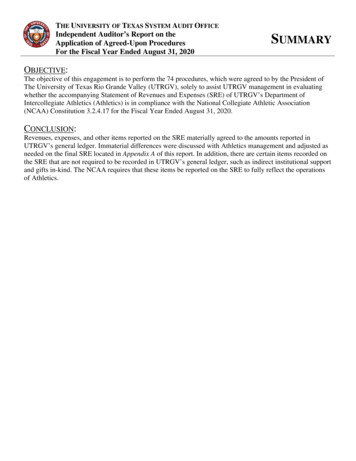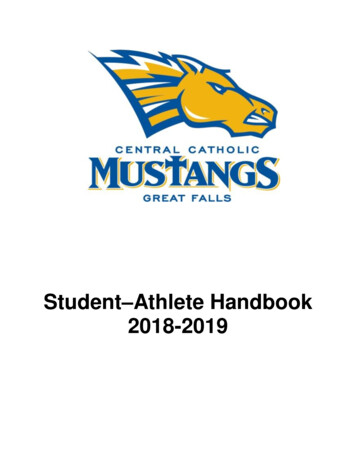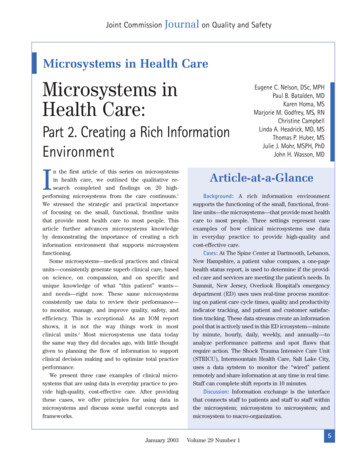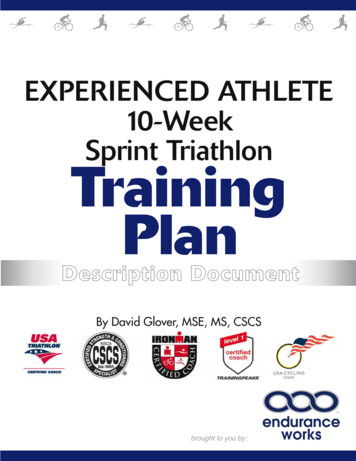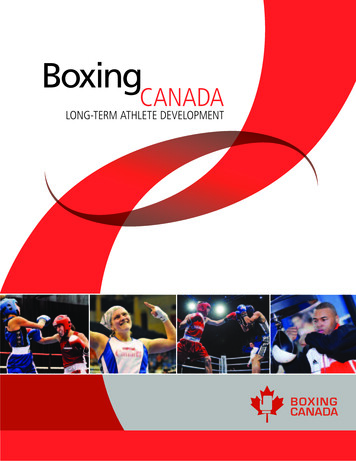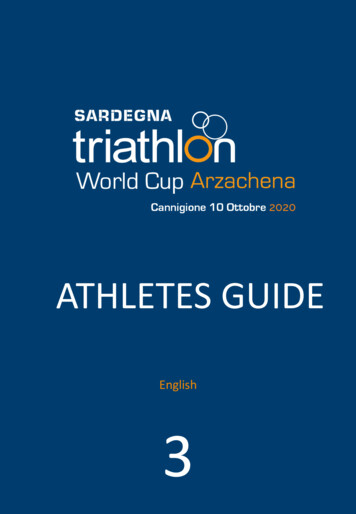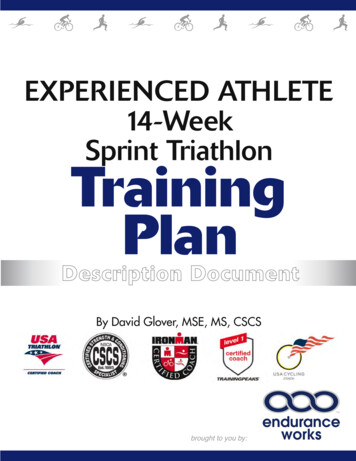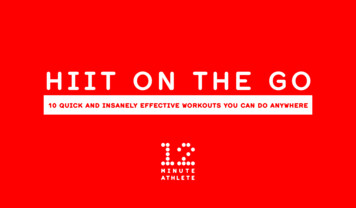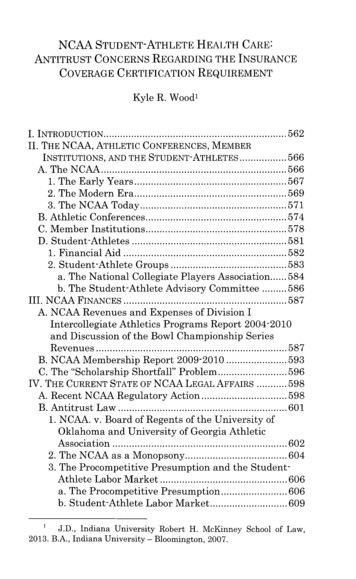
Transcription
NCAA STUDENT-ATHLETE HEALTH CARE:ANTITRUST CONCERNS REGARDING THE INSURANCECOVERAGE CERTIFICATION REQUIREMENTKyle R. Wood 1I. INTRODUCTION.562II.THE NCAA, ATHLETIC CONFERENCES, MEMBERINSTITUTIONS, AND THE STUDENT-ATHLETES .566A. The NCAA. 5661. The Early Years. 5672. The Modern Era. 569. 571.3. The NCAA Today. 574.B. Athletic Conferences. 578C. Member Institutions. 581D. Student-Athletes. 582.1. Financial Aid2. Student-Athlete Groups . 583a. The National Collegiate Players Association.584b. The Student-Athlete Advisory Committee . 586III. NCAA FINANCES.587A. NCAA Revenues and Expenses of Division IIntercollegiate Athletics Programs Report 2004-2010and Discussion of the Bowl Championship SeriesRevenues. 587B. NCAA Membership Report 2009-2010. . 593C. The "Scholarship Shortfall" Problem. 596IV. THE CURRENT STATE OF NCAA LEGAL AFFAIRS . 598A. Recent NCAA Regulatory Action. 598B. Antitrust Law .6011. NCAA. v. Board of Regents of the University ofOklahoma and University of Georgia AthleticAssociation. 6022. The NCAA as a Monopsony. 6043. The Procompetitive Presumption and the StudentAthlete Labor Market. 606a. The Procompetitive Presumption. 606b. Student-Athlete Labor Market. 609J.D., Indiana University Robert H. McKinney School of Law,2013. B.A., Indiana University - Bloomington, 2007.
INDIANA HEALTH LAW REVIEW562C. Public Policy ConcernsVol. 10:2.V. ASSESSING THE MERITS OF NCAA HEALTH CARE.INSURANCE REFORM.VI. CONCLUSION. 616. 626615I. INTRODUCTIONIn 2005, the National Collegiate Athletic Association("NCAA" or the "Association") promulgated a condition andobligation of membership that all member institutions"must certify insurance coverage for medical expensesresulting from athletically related injuries sustained [bystudent-athletes] while participating in a covered event."2 , 3This rule permits that the insurance coverage may beprovided through three possible sources: a policy held by thestudent-athletes parent(s) or guardian(s), a policy held bythe student-athlete personally, or through the institution'sinsurance program. 4 The amount of coverage theinstitutions must certify shall be equal to or greater thanthe deductible amount of the catastrophic injury insuranceprovided by the NCAA.5 That deductible amount is2NAT'L COLLEGIATE ATHLETIC Ass'N, 2011-2012 NCAA DIVISION IMANUAL § 3.2.4.8, at 10 (2011), available at http://www.ncaapublications.com/p-4224-20 11-20 12-ncaa-division-i-manual- august2011.aspx (last visited Mar. 1, 2013) [hereinafter DIVISION I MANUAL].3 DIVISION I MANUAL, supra note 1, § 3.2.4.8.3, at 10-11 ("CoveredEvent. A covered event includes the following: (a) Any intercollegiatesports activity, including team travel, competition, practices andconditioning sessions during the playing season (as defined in Bylaw17.1.1); (b) An NCAA-sanctioned competition in which the insuredperson is an official competitor; or (c) Practice and conditioning sessionsthat are authorized, organized or directly supervised by athleticsdepartment personnel at the member institution other than during theplaying season. Such sessions must occur on campus or at approved offcampus facilities as part of an intercollegiate athletics activity. Forinsured student-athletes or prospective student-athletes who compete inindividual sports, off-campus intercollegiate athletics activities must beauthorized by athletics department personnel at the participating schooland take place at approved locations.").4 DIVIsION I MANUAL, supranote 1, § 3.2.4.8.1, at 10.5Id.
NCAA STrUDENT-ATHLETF HEALTH CARE2013563currently 75,000 or 90,000, depending upon whether theinstitution participates in the NCAA Group Basic AccidentMedical Program.6 In essence, a student-athlete must havehealth care insurance up to at least 75,000 or 90,000 forathletic-related injuries prior to participation in an NCAAsponsored event. NCAA member institutions mayvoluntarily provide health care insurance for their studentathletes, but there is no requirement to do so.Despite this series of requirements, the rule in practicedoes not require that student-athletes have health careinsurance that will actually cover any medical expensesincurred during participation in a "covered event."7 Theoverview of legislation accompanying bylaw 3.2.4.8specifically states that insurance coverage that is subject toout-of-state coverage limitations would satisfy therequirements for certification even if the student-athleteattends an institution in a state in which the insurancecoverage is void.8 This is only one example of how,notwithstanding a series of rules intended to ensure thehealth and safety of student-athletes, those young rticipation may not be adequately protected. Otherpotential roadblocks to adequate coverage include policyexceptions for injuries sustained during collegiate orNat'1 Collegiate Athletic Ass'n., Catastrophic Injury InsuranceProgramBenefit Summary for the Period8/1/12 through 7/31/13, NCAA(Jul. 30, 2012), AA Insurance Programs/Student Athlete Insurance Programs/Catastrophic Insurance Program; NCAA Group Insurance Programs,NCAA, http://www.ncaainsurance.com/ (last visited Mar. 1, 2013).7Kristina Peterson, College Athletes Stuck With the Bill AfterInjuries, N.Y. TIMES, Jul. 16, 2009, at Al, available at s.html (last visited Mar. 1,2013).8Id. (follow hyperlink "The N.C.A.A. explains to colleges how tocomply with N.C.A.A. health insurance rules" to the NCAA Overview ofLegislation; scroll to "Question 9": "[Question:] If a student-athlete hascoverage through an HMO that' s only valid in the state they live in,does that satisfy the requirement if they are in a school outside thatstate? [Answer:] Yes. However, again it should be disclosed to theparent/guardian that they are responsible for any costs not paid byinsurance if the university does not cover those costs.").6
INDIANA HEALTH LAW REVIEW564Vol. 10:2intercollegiate athletic participation, 9 diagnosis of theailment as an illness rather than an injury,' 0 and the costconcerns of the individual student-athlete.1 Without healthcare insurance provided by the member institution, there isa substantial burden for an inexperienced student-athlete toovercome in order to be assured any injury suffered duringathletic participation will not leave them faced withsignificant medical debt.12 This burden has led severalMy alma mater, Indiana University, is one of severaluniversities that excepts coverage for injuries sustained during collegeor intercollegiate sports participation from the basic student health careinsurance offered by the university. See 2012-2013 INDIANA UNIVERSITY,STUDENT HEALTH INSURANCE PLAN FOR INDIANA UNIVERSITYUNDERGRADUATE AND GRADUATE STUDENTS (2012), available /student-voluntarybroch 201213.pdf (insurance underwritten by Aetna Life InsuranceCompany). See also Peterson, supra note 6 (follow hyperlink "Studenthealth care policies from SUNY Buffalo and Florida State showing thatthe default school plans exclude varsity sports injuries") (showing bothpolicies also underwritten by Aetna Life Insurance Company).10Peterson, supra note 6 (Presenting the story of Erin Knauer,Colgate University student-athlete who sustained injury to her backand legs during training for the crew team. "Her symptoms were laterdiagnosed as postviral myositis, a muscular inflammation that cancause weakness and pain. Because Colgate officials deemed the9condition an illness - not an athletic injury - they said financialresponsibility [for approximately 80,000 in medical bills] fell toKnauer.").11 It should be noted that while recent changes under The PatientProtection and Affordable Care Act allow individuals to remain coveredunder insurance policies held by their legal guardian(s) until they reachtwenty-six years old, there is no certainty that the policy held by astudent-athlete's guardian(s) will qualify for certification or adequatelycover the health care needs of the student-athlete, assuming of coursetheir guardian(s) in fact holds health care insurance. These studentathletes may be required to purchase policies for themselves requiringthe student-athlete or their guardian(s) to pay a substantial monthlyfee. The student health insurance offered by Indiana University - whichexcludes college and intercollegiate sports injuries - costs 1,999.00annually for a 1000.00 deductible. See Voluntary Student HealthInsurance 2012-2013, studentvoluntary2012-13.html (last visited Mar. 1, 2013).12See Jacob Dirr, College Athletes: Winners or Losers When ItComes to Health Insurance?, INSURANCEQUOTES.COM, llege-athletes/(last visitedMar. 1, 2013) (explaining how between the years of 1988-89 through
2013NCAA STUDENT-ATHLETI; III ALTll CAR5565individuals and organizations to call for the NCAA tomandate that its member institutions provide health careinsurance coverage for all student-athletes. 1 3This note will set forth and analyze concerns facing theNCAA specifically related to health care coverage ofstudent- athletes for athletically-related injuries. Thoseconcerns implicate numerous public policy issues andpotential antitrust liability. Initially, section II will examinethe relationships between the NCAA, athletic conferences,member institutions, and the student-athletes (includingactive student-athlete representational groups), addressingthe stated intents of the parties where applicable. SectionIII reviews the financial situations of the NCAA, memberconferences and member institutions; specifically, briefaudits of the NCAA Revenue Report for 2004-2010 and theNCAA Membership Report for 2009-2010 will be conducted,along with a review of recent financial developments for themembership, followed by an explanation of the "scholarshipshortfall" problem. Section IV analyzes recent attempts atregulatory changes by the NCAA, NCAA antitrustjurisprudence including the recent development of studentathletes as a relevant labor market, and the increasingvolume of public policy concerns over the Association'sgovernance. Section V assesses the merits of an antitrustchallenge to the current NCAA bylaws regarding studentathlete health care coverage certification and voluntarycoverage by member institutions, and the NCAA revenue2003-04, there were reported more than 182,000 student-athleteinjuries sustained during competition and practice in fifteen majorsports, citing data published in The Journal of Athletic Training).13Press Release, Nat'l College Players Ass'n, California andIndiana Lawmakers to Push Athletes Bill of Rights (Feb. 12, 2012),available at http://ncpanow.org/releasesadvisories?id 0020(NCPAModel Legislation seeks to mandate institutions with financialresources to provide for all student-athlete medical costs); White v.NCAA, No. CVO6-0999 VBF (MANx) (C.D. Cal. 2008) (showingstipulation and agreement of settlement) (including plaintiffs' claim forhealth care costs in complaint); of Peterson, supra note 6 (" 'The onlyway to increase coverage would be to make it mandatory,' " said JoeD'Antonio, the chairman of the N.C.A.A.'s legislative council andassociate commissioner of the Big East Conference. 'It could be toodemanding financially on some of our institutions.' ").
566INDIANA HEALTH LAW REVIEWVol. 10:2distribution formula. Section V also suggests measures forthe NCAA and its membership to avoid potential litigationand possible financial strategies to fund the most accessiblecomprehensive health care program for student-athletes.II. THE NCAA, ATHLETIC CONFERENCES, MEMBERINSTITUTIONS, AND THE STUDENT-ATHLETESIt is a common misconception that NCAA regulationsgovern all of the structural aspects and decision-makingprocesses of the athletic conferences and memberinstitutions. To an unversed observer, conferences appearmuch like divisions in professional sporting leagues. This isnot the case. While there is some overlapping of governanceand indeed a hierarchy of command, both the athleticconferences and member institutions are left with a widerange of discretion in numerous facets of athleticoperations. The most obvious difference is that theindividual contract rights of the NCAA, the athleticconferences and the member institutions are restricted farless in relation to one another than the contract rights ofsimilarly situated parties in professional sports leagues(imagine if you will the Atlanta Hawks contracting to movefrom the Southeast Division to the Atlantic Division of theEastern Conference in the NBA, a move similar to the enmasse conference realignments taking place in moderncollege sports). Beyond the respective contract rights of theparties, each have their own economic structures and makedecisions based on individualized goals that may or may notconform with the goals of the other parties to a greaterextent than is typical of professional sports leagues.A. The NC4A[T]heNationalCollegiateAthleticAssociation[ I is a voluntary, non-profitstandard- setting association that promulgatesthe rules of competition for and operatesannual national championships in [231 sportsacross three divisions. Its membership includes
NCAA STUDENT-ATHLiTH HEALTH CARE2013567over 1,200 educational institutions, athleticconferences, and related organizations. Itpromulgates rules of play, recruiting, length ofequipmentandseason,amateurism,andregulations, operates championships14maintains intercollegiate athletics records.The NCAA consists of over 440,000 student-athleteswho compete in eighty-nine national championships. 15, 161. The Early YearsIn the beginning, college football was more reminiscentof ancient Roman gladiator games than the comparablydocile contest it is today. Between the years 1890-1905,football game-related injuries resulted in the deaths of 330players.17 With national concern over the brutal nature ofthe sport generating an overwhelming call for reform or thetotal abolition of the sport, President Theodore Rooseveltconvened collegiate athletic leaders to two White Houseconferences to discuss reform in 1905.18 Later that sameIn re NCAA I-A Walk-On Football Players Litigation, 398 F.Supp. 2d 1144, 1146 (W.D. Wash. 2005) (since publication, the NCAAhas increased the operation of national championships from 22 sports to23). See NAT'L COLLEGIATE ATHLETIC ASS'N, 2009-10 NCAAMEMBERSHIP REPORT 36 (2010) available at http://catalog.proemags.142013)(last visited Mar. 1,com/publication/Oaffe96d#/Oaffe96d/1[hereinafter MEMBERSHIP REPORT].15 NAT'L COLLEGIATE ATHLETIC Ass'N, 1981-82 - 2010-11 NCAASPORTS SPONSORSHIP AND PARTICIPATION RATES REPORT 5 (2011),available at ip-and-participation-rates-report.aspx (last visitedMar. 1, 2013) [hereinafter SPORTS SPONSORSHIP AND PARTICIPATION RATESREPORT].Who We Are, NCAA, http://ncaa.org/wps/wcm/connect/public/ncaa/about the ncaa/who we are landing page (last visited Mar. 1,162013).17Daniel E. Lazaroff, The NCAA in its Second Century: Defenderof Amateurism or Antitrust Recidivist?, 86 OR. L. REV. 329, 332 (2007)(citing ANDREW ZIMBALIST, UNPAID PROFESSIONALS 8 (1999) [hereinafterZIMBALIST]).18History, AA/About the NCAA/History (last visited Mar. 1, 2013).
568INDIANA HEALTH LAW REVIEWVol. 10:2year, Chancellor Henry M. MacCracken of New YorkUniversity convened a meeting of thirteen institutions toratify the needed reformation of college football playingrules with a focus on the health and safety of studentathletes. At a subsequent meeting held on December 28,1905 in New York City, less than a month after ChancellorMacCracken's initial meeting, sixty-two colleges anduniversities became charter members of the IntercollegiateAthletic Association of the United States (IAAUS).19 OnMarch 31, 1906, the IAAUS was officially constituted. Itwould operate under that name until 1910, when theAssociation took its present name, the National CollegiateAthletic Association. 20 From its formation, the overarchingpurpose of NCAA regulations was to protect the health andsafety of student-athletes.For the first fifteen years, the NCAA was almostexclusively a discussion group and rulemaking body. Whilefootball violence was the initial trigger for the creation ofthe NCAA, early NCAA rules turned their focus stronglytoward regulations "relating to amateurism and eligibilityrules."2 1 These early amateurism and eligibility rulesbanned all institutions from awarding any scholarships orfinancial aid based on athletic rather than academicability. 2 2 The NCAA officially defined "amateur athlete" in1916 as "one who participates in competitive physical sportsonly for the pleasure, and the physical, mental, moral, andsocial benefits directly derived therefrom." 23 Beyondreforming the rules of college football and definingstandards of eligibility, the NCAA did little more duringthis initial period.The NCAA expanded its role in college sports in 1921,holding the first NCAA national championship: theNational Collegiate Track and Field Championships. The19Id.20Id.Lazaroff, supra note 16, at 332 (citing ALLEN L. SACK & ELLEN J.STAUROWSKY, COLLEGE ATHLETES FOR HIRE 33 (1998) [hereinafterSACK]).212223Id.Id. (citing NAT'L COLLEGIATE ATHLETIC ASS'N, PROCEEDINGS OFTHE ELEVENTH ANNUAL CONVENTION 118 (1916)).
NCAA STUDENT-ATHLETr HEALTH CARE2013569following year, the NCAA altered slightly its definition of"amateur athlete" to "one who engages in sport solely for thephysical, mental, or social benefits he derives therefrom,and to whom the sport is nothing more than an avocation."24This definition reaffirmed the restrictions barring athletesfrom receiving financial aid based on athletic abilities. Overthe next three decades, the NCAA expanded further,creating more rules committees and forming additionalnational championships (most notably, the Men's BasketballChampionship in 1939).25 Yet, with the tremendous growthin the popularity of college football it became exceedinglydifficult to enforce the NCAA amateur code. 26 The NCAAhad no enforcement powers. Policing of the regulationspromulgated by the NCAA was left to the conferences andmember institutions to self-enforce. 27 "Increasingly, it hadbecome evident that reliance upon voluntary compliance byNCAA member institutions would not solve the myriadproblems created by the dramaticexpansion ofintercollegiate athletics and the [financial] opportunitiessuch growth presented." 28 Absent a credible enforcementagency, the financial rewards associated with athleticsuccess presented an enticement that led too manyinstitutions and individuals to ignore NCAA regulationswith tremendous regularity. 29 Voluntary compliance was anillusory agreement among the membership.2. The Modern EraIn 1948, the NCAA adopted the "Sanity Code" in anattempt to effectuate compliance with its rules and24Id. (citing NAT'L COLLEGIATE ATHLETIC ASS'N, PROCEEDINGS OFTHE SEVENTEENTH ANNUAL CONVENTION (1922)).2526History, supra note 17.Lazaroff, supra note 16, at 332 (citing ARTHUR A. FLEISHER IIIET AL., THE NATIONAL COLLEGIATE ATHLETIC ASSOCIATION: A STUDY INCARTEL B
insurance program.4 The amount of coverage the institutions must certify shall be equal to or greater than the deductible amount of the catastrophic injury insurance provided by the NCAA.5 That deductible amount is 2 N

